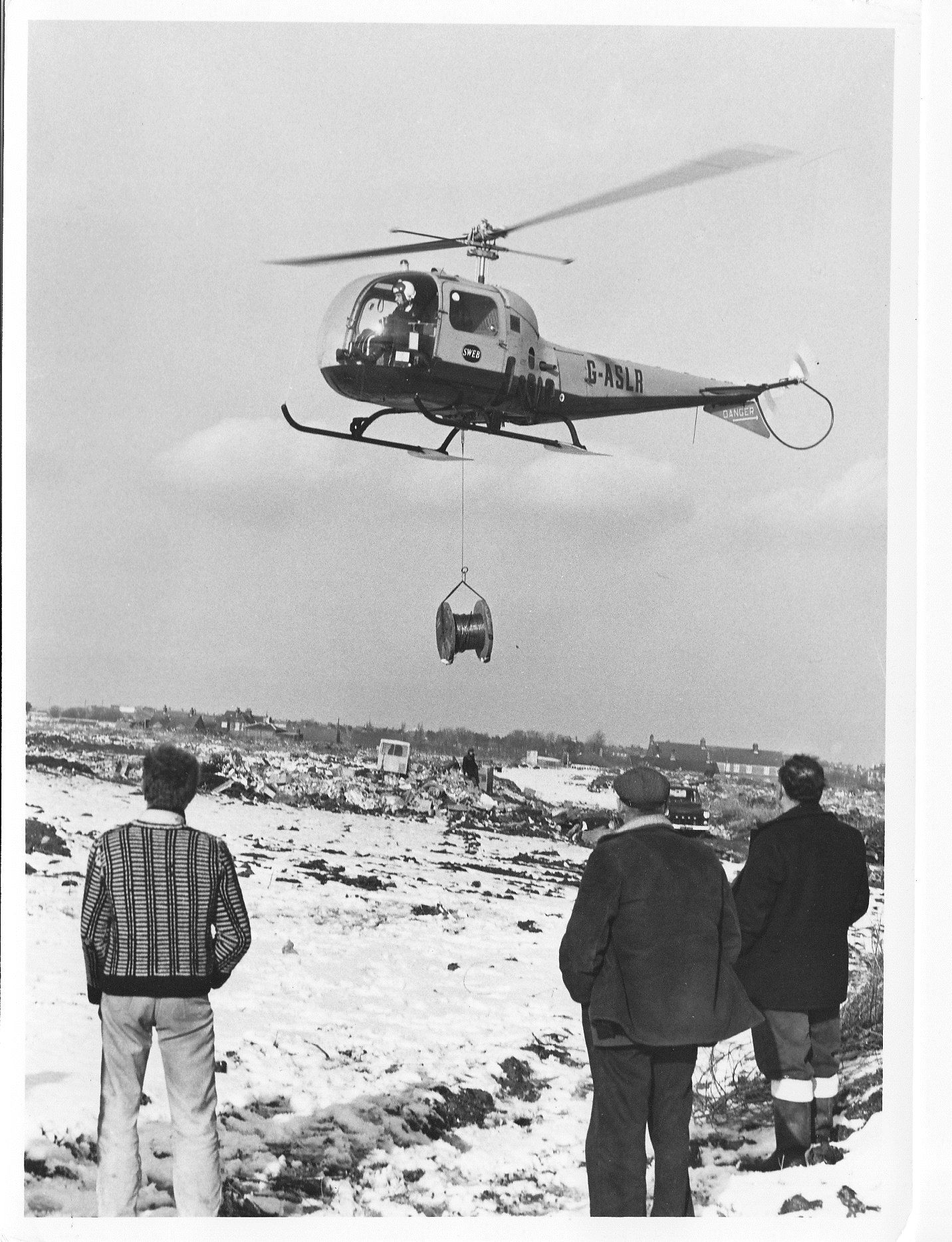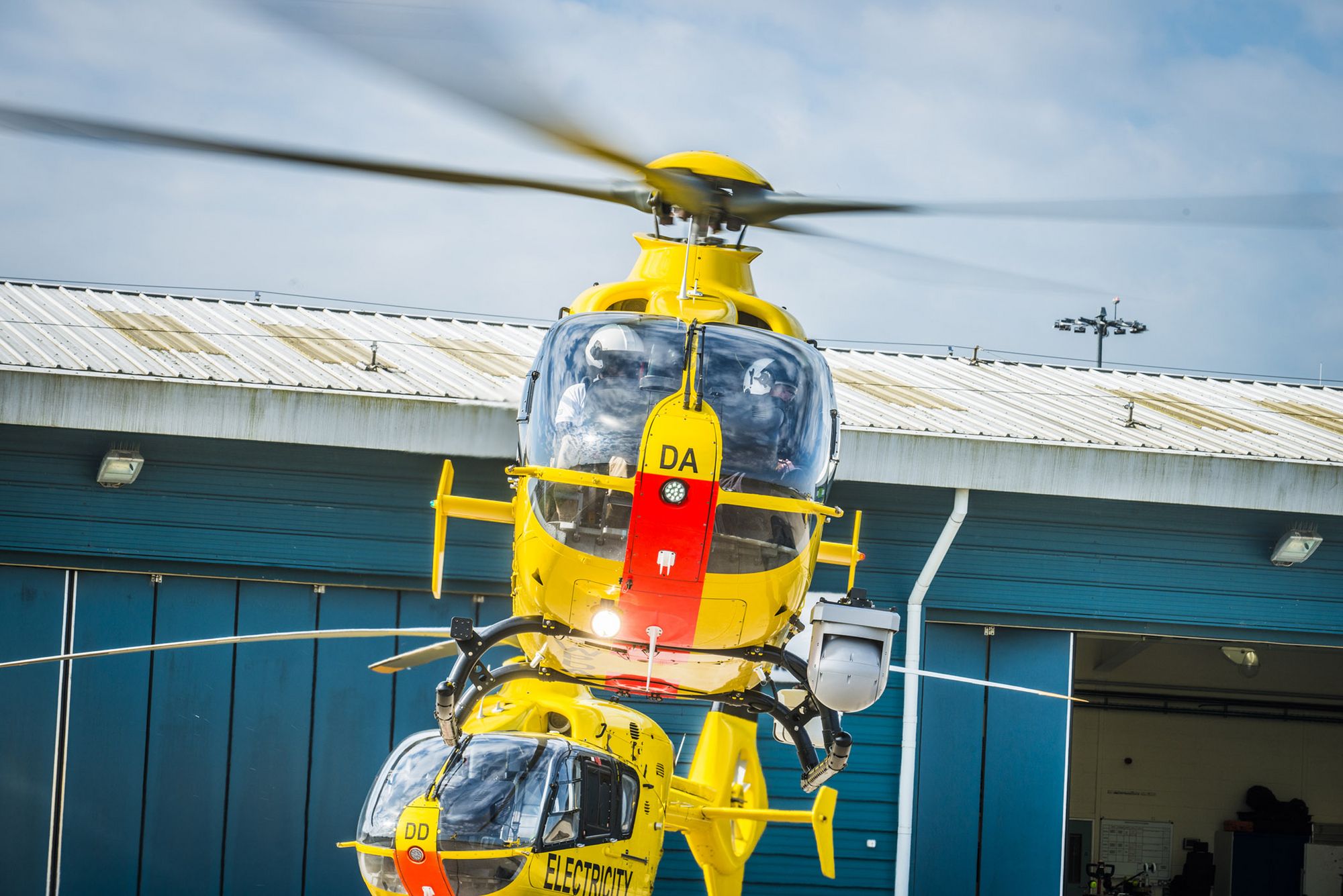60 Years of the Helicopter Unit

It was the year The Beatles released their debut album, the creators of Dr Who introduced the Daleks and a helicopter took off in Bristol for the first flight in a three-year ‘test and utilisation’ study to see if it could replace ‘walking the lines’.
Back in 1963 overhead line inspections were carried out by two men who would spend days walking under the network looking for faults. There was an obvious problem: while they could see the bottom and sides of the lines, they couldn’t see any damage on the top.
It was a well-known issue and attempts to solve it had begun years before. A game of golf with helicopter pilot Charles Hosegood – known as Sox – had provided the then chief executive of SWEB with the idea of taking to the skies in 1960.
But it took some time and persuasion for the Electricity Council to fund the study. One of the main difficulties was that the helicopter identified as the most suitable for the job – an Agusta Bell 47J with a top speed of 100 miles per hour and a range of 270 miles – wasn’t British. Eventually, funds were secured and Sox became the unit’s first pilot.
The unusually snowy November of 1965 saw the helicopter come into its own as it was able to inspect and transport equipment to places where men in land-based vehicles couldn’t go. The research project became a permanent fixture.
In 1968 an AB 206A Jet Ranger became the first turbine-powered aircraft to join the fleet.
The Helicopter Unit’s accountable manager Robin Tutcher said: “It was a vast improvement and was considered ideal in every respect. During the 1970s the unit’s flying commitments increased sufficiently to warrant the purchase of a second Jet Ranger in 1980 and a third in 1982.
“By now the unit’s total annual flying had increased to 1,500 hours and the first of two AS355 Twin Squirrels arrived. One of the Jet Rangers was released in favour of the second Twin Squirrel and the fleet number remained steady at four until 2010, when it increased to five with the purchase of a third Bell 206 Jet Ranger.”
The Helicopter Unit had always been based at Bristol Airport – in fact, it’s the airport’s oldest customer – but with a fleet of five helicopters more space was needed. A sizeable hangar and attached offices were built in 1990 but the continued expansion of the airport saw the unit being moved to the south side in 2007, where it remains today.
Guests at the showcase celebration included a senior official from the Department for Transport – who was so fascinated he stayed for most of the day – and visitors from the aviation industry. The ‘drop in and explore’ format allowed guests to understand what today’s aircraft – five Airbus EC135s – and the unit are capable of and how its role has expanded.
Until 2017, the helicopters’ prime uses had been routine line inspection plus delivering poles, people and heavy loads to inaccessible areas but that year discussions began regarding additional capabilities and technology.
Robin explained: “One of the key things an electricity distribution company has to do is manage vegetation near its assets. Our idea was that if we were inspecting overhead lines anyway, why shouldn’t we combine that with vegetation inspection using LiDAR?”
The result was a three-year procurement, certification and modification process by the unit and Babcock to equip all five aircraft with Trakka SWE 400 cameras and Riegl LiDAR systems as well as a comprehensive multi-screen mission management system with CarteNav software at the heart of it.
This modification allows the provision of a visual inspection provided by the observer (front left seat) plus a non-visual inspection (thermal and corona) and LiDAR capture co-ordinated by the mission system operator (rear left seat) at the same time on any voltage.
The Trakka cameras have a role in helping to prepare the network for net zero by increasing efficiency. Instead of having to replace a whole tower, the definition and accuracy of the cameras allows us to replace or repair specific sections. That not only saves on cost but gives assets a longer lifespan, which benefits the environment.
And that’s not the end of the development and innovation. Last year, the unit became the first rotary operator in the UK to successfully trial sustainable aviation fuel. Plans for a longer-term trial are being compiled.
The unit is also collaborating with a number of large rotary Remote Piloted Aircraft System manufacturers to explore the use of unmanned aircraft to work alongside the helicopters for inspection purposes. This is a long-term project to ensure that the capabilities developed within the manned aviation sector are at least replicated.
With an increasing number of smart assets installed on the network that all require monitoring, there’s no shortage of tasks for the Helicopter Unit. The only question is what advances will it have made by its platinum anniversary in 2033?

